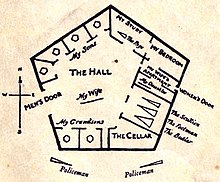Disusun Ulang Oleh:
Arip Nurahman
Department of Physics
Faculty of Sciences and Mathematics, Indonesia University of Education
and
Follower Open Course Ware at Massachusetts Institute of Technology
Cambridge, USA
Department of Physics
http://web.mit.edu/physics/
http://ocw.mit.edu/OcwWeb/Physics/index.htm
&
Aeronautics and Astronautics Engineering
http://web.mit.edu/aeroastro/www/
http://ocw.mit.edu/OcwWeb/Aeronautics-and-Astronautics/index.htm


A parallel universe or alternative reality is a hypothetical self-contained separate reality coexisting with one's own. A specific group of parallel universes is called a "multiverse", although this term can also be used to describe the possible parallel universes that constitute reality. While the terms "parallel universe" and "alternative reality" are generally synonymous and can be used interchangeably in most cases, there is sometimes an additional connotation implied with the term "alternative reality" that implies that the reality is a variant of our own. The term "parallel universe" is more general, without any connotations implying a relationship, or lack of relationship, with our own universe. A universe where the very laws of nature are different – for example, one in which there are no relativistic limitations and the speed of light can be exceeded – would in general count as a parallel universe but not an alternative reality. The correct quantum mechanical definition of parallel universes is "universes that are separated from each other by a single quantum event."
Science fiction
While technically incorrect, and looked down upon by hard science-fiction fans and authors, the idea of another “dimension” has become synonymous with the term “parallel universe”. The usage is particularly common in movies, television and comic books and much less so in modern prose science fiction. The idea of a parallel world was first introduced in comic books with the publication of Flash #123 - "Flash of Two Worlds".
In written science fiction, “new dimensions” more commonly — and more accurately — refer to additional coordinate axes, beyond the three spatial axes with which we are familiar. By proposing travel along these extra axes, which are not normally perceptible, the traveler can reach worlds that are otherwise unreachable and invisible.
In 1884, Edwin A. Abbott wrote the seminal novel exploring this concept called Flatland: A Romance of Many Dimensions. It describes a world of two dimensions inhabited by living squares, triangles, and circles, called Flatland, as well as Pointland (0 dimensions), Lineland (1 dimension), and Spaceland (three dimensions) and finally posits the possibilities of even greater dimensions. Isaac Asimov, in his foreword to the Signet Classics 1984 edition, described Flatland as "The best introduction one can find into the manner of perceiving dimensions."
In 1895, The Time Machine by H. G. Wells used time as an additional “dimension” in this sense, taking the four-dimensional model of classical physics and interpreting time as a space-like dimension in which humans could travel with the right equipment. Wells also used the concept of parallel universes as a consequence of time as the fourth dimension in stories like The Wonderful Visit and Men Like Gods, an idea proposed by the astronomer Simon Newcomb, who talked about both time and parallel universes; "Add a fourth dimension to space, and there is room for an indefinite number of universes, all alongside of each other, as there is for an indefinite number of sheets of paper when we pile them upon each other".
There are many examples where authors have explicitly created additional spatial dimensions for their characters to travel in, to reach parallel universes. In Doctor Who, the Doctor accidentally enters a parallel universe while attempting to repair the TARDIS console in Inferno. The parallel universe was similar to the real universe but with some different aspects. Douglas Adams, in the last book of the Hitchhiker's Guide to the Galaxy series, Mostly Harmless, uses the idea of probability as an extra axis in addition to the classical four dimensions of space and time similar to the many-worlds interpretation of quantum physics.
Though, according to the novel, they're not really parallel universes at all but only a model to capture the continuity of space, time and probability. Robert A. Heinlein, in The Number of the Beast, postulated a six-dimensional universe. In addition to the three spatial dimensions, he invoked symmetry to add two new temporal dimensions, so there would be two sets of three. Like the fourth dimension of H. G. Wells’ "Time Traveller", these extra dimensions can be traveled by persons using the right equipment.
References
Notes
- ^ Carl Sagan, Placido P D'Souza (1980s). Hindu cosmology's time-scale for the universe is in consonance with modern science.; Dick Teresi (2002). Lost Discoveries : The Ancient Roots of Modern Science - from the Babylonians to the Maya.
- ^ Irwin, Robert (2003). The Arabian Nights: A Companion. Tauris Parke Paperbacks. p. 209. ISBN 1860649831.
- ^ Briggs (1967) p.50-1
- ^ Gareth Matthews, "Plato in Narnia" p 171 Gregory Bassham ed. and Jerry L. Walls, ed. The Chronicles of Narnia and Philosophy ISBN 0-8126-9588-7
- ^ Stephen Baxter Speech
- ^ a b C. S. Lewis, "On Science Fiction", Of Other Worlds, p68 ISBN 0-15-667897-7
- ^ "John Grant" interviewed by Lou Anders, accessed 24 October 2009
- ^ Michael Moorcock, Wizardry & Wild Romance: A Study of Epic Fantasy p 88 ISBN 1-932265-07-4
Further reading
- Clifford A. Pickover (August 2005). Sex, Drugs, Einstein, and Elves: Sushi, Psychedelics, Parallel Universes, and the Quest for Transcendence (Discusses parallel universes in a variety of settings, from physics to psychedelic visions to Proust parallel worlds to Bonnet syndrome). Smart Publications. ISBN 1-890572-17-9.
- Michio Kaku (2004). Parallel Worlds: A Journey Through Creation, Higher Dimensions, and the Future of the Cosmos. Doubleday. ISBN 0-385-50986-3.
























